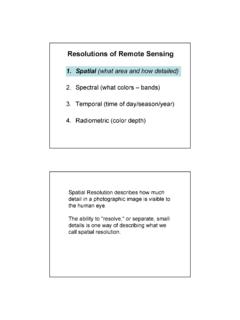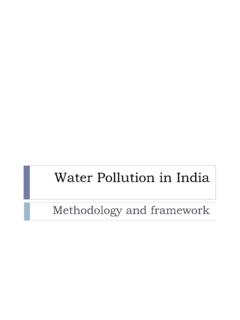Transcription of EIA Methods and Techniques (Impact Identification)
1 EIA Methods and Techniques (Impact Identification) Md. Esraz-Ul-Zannat Assistant Professor Department of Urban and Regional Planning Khulna University of Engineering & Technology URP 4141: Environmental Planning and Management April 17, 2018 EIA EIA is a systematic process to identify, predict and evaluate the environmental effects of proposed actions in order to aid decision making regarding the significant environmental consequences of projects, developments and programmes. Origin of EIA The USA decided to respond to environmental issues and established a National Environmental Policy Act in 1970 to consider its goal in terms of environmental protection. The USA became the first country to enact legislation on EIA. This was the first time that EIA became the official tool to be used to protect the environment.
2 The United Nations Conference on the Environment in Stockholm in 1972 and subsequent conventions formalized EIA. At present, all developed countries have environmental laws whereas most of the developing countries are still adopting it (Lee, 1995). Multilateral and bilateral lenders included EIA requirements in their project eligibility criteria (OECD, 1996). EIA Methodologies EIA Methodologies developed to identify, predict and value changes of an action. The development of methodologies to assess impacts depend on: The relationship between territorial elements (or Characteristics) and the actions The specific measurements and the necessary information to estimate the impacts. The mitigation measures, compensation and follow-up. Choice of EIA method depends on To ensure compliance with regulations.
3 To provide a comprehensive coverage of a full range of impacts, including social, economic and physical. To distinguish between positive and negative, large and small, long term and short term, reversible and irreversible impacts. To identify secondary, indirect and cumulative impacts as well as direct impacts To distinguish between significant and insignificant impacts Choice of EIA method depends on To allow comparison of alternative development proposal. To consider impacts within the constraints of an area s carrying capacity To incorporate qualitative as well as quantitative information To be easy and economical to use. To be unbiased and to give consistent result. To be of use in summarizing and presenting impacts in the EIS. Objectives of Methodologies the nature and location of the project and possible alternatives factors of analysis and assessment objectives identification of impacts and scoping studies and evolution in the absence of projects and assessment of impacts and alternatives comparison and Impacts management.
4 Methods of Impact Identification There are five main classes of quantitative impact identification Techniques exist: Checklist Matrices Networks Map Overlay Ad hoc method Checklist Checklists are comprehensive lists of environmental effects and impact indicators designed to stimulate the analyst to think broadly about possible consequences of contemplated actions. Checklist: Types There are four types of cheklist: concern Checklist Simple Checklist A list of environmental parameters with no guidelines on how they are to be measured and interpreted. Descriptive Checklist Includes an identification of environmental parameters and guidelines on how to measure data on particular parameters. Questionnaire Checklist Are based on a set of questions to be answered.
5 Some of the questions may concern indirect impacts and possible mitigation measures. They may also provide a scale for classifying estimated impacts from highly adverse to highly beneficial. Questionnaire Checklist Questionnaire Checklist Aspects of EIAC hecklist QuestionsWill the project:Yes NoAdditionalData needsSources of the acquisition or conversion of significant areasof land for reservoir/treatment works etc. ( > 50 harural, > 5 ha urban)? in significant quantities of eroded material, effluentor solid wastes? significant accommodation or service amenities tosupport the workforce during construction (eg > 100manual workers)?Receptors of or otherwise affect areas which supportconservation worthy terrestrial or aquatic ecosystems,flora or fauna (eg protected areas, wilderness areas,forest reserves, critical habitats, endangered species); orthat contain sites of historical or cultural importance?
6 Or otherwise affect areas which will affect thelivelihoods of local people (eg require populationresettlement; affect local industry, agriculture, livestockor fish stocks; reduce the availability of natural resourcegoods and services)? siting sanitation treatment facilities close tohuman settlements (particularly where locations aresusceptible to flooding)? sources of water extraction?Environmental a noticeable permanent or seasonal reduction inthe volume of ground or surface water supply? a significant pollution risk through liquid or solidwastes to humans, sources of water extraction,conservation worthy aquatic ecosystems and species, orcommercial fish stocks? the local hydrology of surface water-bodies (egstreams, rivers, lakes) such that conservation-worthy orcommercially significant fish stocks are affected?
7 11. Increase the risk of diseases in areas of high populationdensity (eg onchocerciasis, filariasis, malaria, hepatitis,gastrointestinal diseases)? secondary development, eg along access roads,or in the form of entrepreneurial services for constructionand operational activities?Mitigation likely to require mitigation measures that may result inthe project being financially or socially unacceptable?CommentsI recommend that the programme be assigned toCategorySignature: Checklist Consist of a list of environmnetal components and , for each component, a threshold at which those assessing a proposal should become concerned with an impact. The implication of alternative proposals can be seen by examining the number of times that an alternative exceeds the threshold of concern.
8 Threshold Checklist Scaling Checklist similar to a descriptive checklist, but with additional information on subjective scaling of the parameters. Advantages of Checklist There are several major reasons for using checklists: They are useful in summarizing information to make it accessible to specialists from other fields, or to decision makers who may have a limited amount of technical knowledge; scaling checklists provide a preliminary level of analysis; and weighting is a mechanism for incorporating information about ecosystem functions. Disadvantages of Checklist Westman (1985) listed some of the problems with checklists when used as an impact assessment method: 1. They are too general or incomplete; 2. They do not illustrate interactions between effects; 3.
9 The number of categories to be reviewed can be immense, thus distracting from the most significant impacts; and 4. The identification of effects is qualitative and subjective. Matrix Matrix are two-dimensional tables which facilitate the identification of impacts arising from the interaction between project activities and specific environmental components. They are essentially expansions of checklists that acknowldge the fact that different component of development project ( Construction, operation,decommissioning, buildings, access road) The entries in the cell of the matrix can be either qualitative or quantitative estimates of impact. Types of Matrix Simple Matrix Time dependent matrix Magnitude Matrix Quantified Matrix (Leopold Matrix) Weighted Matrix Simple Matrix Time Dependent Matrices Includes a number sequence to represent the time scale ( one figure per year) of the impacts Magnitude Matrices Go beyond the mere identification of impacts according to their magnitude, importance and or time frame ( short, medium or long term) Quantified Matrix The best known type of quantified matrix is the Leopold Matrix, which was developed for the US geological survey by Leopold et al.
10 This matrix is based on a horizontal list of 100 project action and a vertical list of 88 environemntal components. Example of Leopold Matrix How to Use Quantified Matrix Identify All actions that are part of the proposed project Under each of the proposed actions, place a slash at inter section with each item in the side of the matrix if an impact in possible. How to Use Quantified Matrix In the upper left hand corner of each box with a slash, place a number from 1 to 10 which indicate the Magnitude of the possible impact; 10 represents- the greatest magnitude of impact and 1, the least (no zeroes). Before each number place + (id the impact would be beneficial) In the lower right hand corner of the box place a number 1 to 10 which indicates the importance of the possible impact ( regional vs local); 10 represents the greatest importance and 1 the least (non zeroes) How to Use Quantified Matrix Leopold Matrix The leopold matrix is easily understood, can be applied to a wide range of developments, and is resonably comprehensive for first order, direct impact It can t reveal indirect effects of development.


